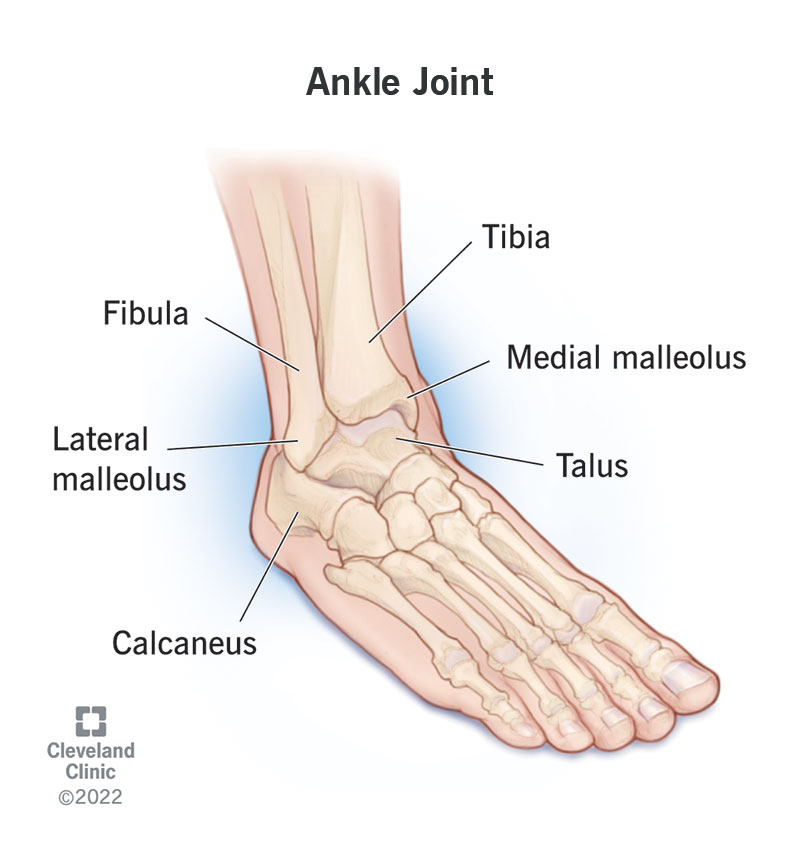The ankle joint is where your shin bone (tibia), calf bone (fibula) and talus bone meet. It joins your foot to your lower leg. Your ankle also contains cartilage, ligaments, muscles, nerves and blood vessels. Your ankles move in two main directions and you use them any time you move your feet and legs.
Advertisement
Cleveland Clinic is a non-profit academic medical center. Advertising on our site helps support our mission. We do not endorse non-Cleveland Clinic products or services. Policy

The ankle is the joint that connects your foot to your lower leg. Healthcare providers sometimes refer to it as the tibiotalar joint or the talocrural joint.
Advertisement
Cleveland Clinic is a non-profit academic medical center. Advertising on our site helps support our mission. We do not endorse non-Cleveland Clinic products or services. Policy
Like all joints, your ankles are part of your skeletal system. Your ankles also contain cartilage, muscles, ligaments and nerves.
Visit a healthcare provider if you’re experiencing ankle pain. They’ll diagnose what’s causing your pain and other symptoms and will suggest treatments that’ll help you get back to your usual routine and activities.
Your ankles bend and flex anytime you’re moving to keep you stable and maintain your balance.
Your ankles move in two directions:
The ankle is at the lower end of your leg. It’s where your lower leg meets your foot.
There are lots of joints and many ways healthcare providers group them together. Joints are usually classified based on:
The ankle is a synovial joint. Synovial joints have the most freedom to move. They’re made of a cavity in one bone that another bone fits into. Slippery hyaline cartilage covers the ends of bones that make up a synovial joint. A synovial membrane — a fluid-filled sac that lubricates and protects the joint — lines the space between the bones. This extra cushioning helps synovial joints move with as little friction as possible.
Advertisement
Functionally, the ankle is a hinge joint. Think about the hinges that hold a door in place. They have a few parts that don’t move, but other pieces move a specific distance to open and close. Your ankle hinges in either direction it can move.
Your ankles are made of:
Three bones make up your ankle joint:
Cartilage is a strong, flexible tissue that protects your joints. It acts as a shock absorber throughout your body. Your ankle is lined with hyaline cartilage. Hyaline cartilage is the most common type of cartilage in your body. Some healthcare providers call it articular cartilage. It lines your joints and caps the ends of your bones.
Hyaline cartilage is slippery and smooth, which helps your bones move smoothly past each other in your joints. The surfaces of your tibia, fibula and talus that touch each other have a hyaline cartilage lining.
Ankle ligaments are like cords that connect bones in your foot to your lower leg bones.
There are three main sets of ligaments in your ankle:
Muscles are soft tissue made of stretchy fibers. They tense up (flex) to pull and move parts of your body. Muscles attached to your legs and feet control your ankle movements.
Muscles that control plantarflexion let you flex your foot down, away from your body. They include the:
Muscles that control dorsiflexion let you move your foot up toward your body. They include the:
Nerves are like cables that carry electrical impulses between your brain and the rest of your body. These impulses help you feel sensations and move your muscles. Nerves in your ankle include the:
Blood vessels are channels that carry blood throughout your body. They form a closed loop, like a circuit, that begins and ends at your heart. Three arteries carry blood to and from your ankle, including the:
Your ankles can be affected by anything that that damages your bones or connective tissue, including:
Advertisement
Sports injuries are some of the most common ankle injuries:
The condition or issue that’s affecting your ankle will determine which symptoms you experience. Many ankle issues cause symptoms like:
Visit a healthcare provider as soon as you notice changes or pain in your ankles. Some of the most common tests providers use to diagnose issues include:
Don’t play sports or do any intense physical activity that can put more stress on your ankle until a healthcare provider says it’s safe. Follow the RICE method as soon as you notice pain or other symptoms:
Advertisement
Visit a healthcare provider if the pain is severe or your ankle still hurts after a few days of at-home care.
Whether you’re scoring the winning goal in a soccer game or walking around your neighborhood, you use your ankles every time you move.
Because we use them so often, ankle injuries are common. You can probably relieve your pain at home with over-the-counter medicines and rest, but don’t ignore symptoms. Visit a healthcare provider if pain, stiffness or swelling in your ankle doesn’t get better after a few days of rest.
Advertisement
Cleveland Clinic’s primary care providers offer lifelong medical care. From sinus infections and high blood pressure to preventive screening, we’re here for you.

Last reviewed on 04/15/2023.
Learn more about the Health Library and our editorial process.